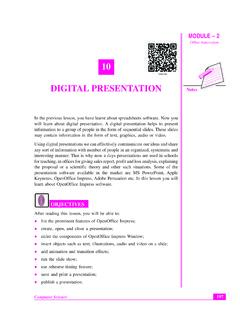Transcription of Introduction to human-computer interaction • What are the ...
1 S510: Introduction to Information Science Fall 14 Introduction to human-computer interaction I. What is HCI? What are the main components of HCI? How has it developed over time? II. Basic concepts and principles The official version III. HCI research Usability Accessibility Visualization S510: Introduction to Information Science Fall 14 I. What is HCI? HCI is The study of the design, evaluation and implementation of interactive computing systems for human use and the major phenomena surrounding them It consists of three parts: the person, the computer, and the ways they work together Who is the human in HCI (the user)? A person with a laptop, a group working together or remotely, a series of people working in A person or persons trying to get a job done using technology S510: Introduction to Information Science Fall 14 I.
2 What is HCI? Who is the human in HCI (the user)? When studying the person, the focus is on physiology, cognitive psychology, and socio -technical action Physiology: ergonomics, human factors What is the range of physiological constraints when using ICTs? How should design take these into account? How small can a PDA keypad be and still be usable? Is this the best type of input device to design? S510: Introduction to Information Science Fall 14 I. What is HCI? Who is the human in HCI (the user)? Cognitive psychology: understanding the ways in which thinking and reasoning play roles in our ICT use What is the role of sensory perception and memory in ICT use and how can this be incorporated into design? Improved legibility of hypertext ( font , background colors) results in improved reading comprehension Distinguishable sounds indicate that a task has been successfully completed Interface design can take advantage of short term memory by providing appropriate stimuli for recall background S510: Introduction to Information Science Fall 14 I.
3 What is HCI? What types of devices are included in computer? Technologies range from grid and supercomputing to desktops, to mobile devices to embedded and pervasive computing Artifacts such as websites, computer games and car interiors Evolution of computing Computing to communication Machinery to habitat Aliens to agents S510: Introduction to Information Science Fall 14 I. What is HCI? Evolution of computing Computing to communication uncategorized/2007/07/12 S510: Introduction to Information Science Fall 14 I. What is HCI? Evolution of computing Machinery to habitat S510: Introduction to Information Science Fall 14 I. What is HCI?
4 Evolution of computing Machinery to habitat: another view images20041028_korean_ wp-content/uploads/2013/11/ technology/mobile/apple- iphone-iwatch-event/ S510: Introduction to Information Science Fall 14 I. What is HCI? Evolution of computing Machinery to habitat: another view It s real! The Bristol Wearable Computing Project in 2002 S510: Introduction to Information Science Fall 14 I. What is HCI? Evolution of computing Machinery to habitat: still another view Ambient Wood (Rogers) S510: Introduction to Information Science Fall 14 Evolution of computing Aliens to agents usage/ 254_ I.
5 What is HCI? S510: Introduction to Information Science Fall 14 I. What is HCI? Evolution of computing Aliens to agents: another view Agents in a collective communicate over secured links on the net or intranet Malicious agents (with horns) are detected and cut off from the collective Properly authenticated data are allowed in but bad data are rejected S510: Introduction to Information Science Fall 14 What types of interactions matter? The directionality goes both ways: we initiate actions when using ICTs and respond to actions initiated by ICT Interactions have empirical features: Human/non-human interactants, beginnings and ends, turn-taking, iteration, use of power and control What is the range of interactions that occur when we use ICTs (particularly computing)?
6 ICTs allow us to interact indirectly A medium through which we interact with each other and our environment that is transforming our lives I. What is HCI? S510: Introduction to Information Science Fall 14 A focus on interaction moves HCI to a consideration of contextual awareness Context: a complex description of shared knowledge about physical, social, historical, or other factors within which an action or an event occurs To understand actions or events, it is necessary to have access to the relevant context in which actions and events occur Delivering information at appropriate times and places to allow people to more effectively run their lives Ex: pop-up reminders of what needs to be done, providing relevant information at a point in time I. What is HCI? S510: Introduction to Information Science Fall 14 I.
7 What is HCI? Knowledge of information behaviour and its relevance!Hepworth argues that sociotechnical trends influence the development of ICTs towards people-centered design!!It is critically important to understand the complexity of !people's information behaviors!!To promote better design, he proposes an ontology of !!information behavior research !~Do you agree with his idea of inclusion: all people .. are perceived to have a right to participate and .. access products and services? !~Is the ontology sensible? Is anything left out?!S510: Introduction to Information Science Fall 14 I. What is HCI? The direction in computing and ICTs is towards people-centered design Trends: commodification of information; inclusion personalization; information overload; virtual learning environments A combination of social norms and technologies has led to a need to create usable electronic environments People want to become informed in effective ways The environment must respond to the complex cultural and psychological needs of the consumer Hepworth, M.
8 (2007). Knowledge of information behaviour and its relevance to the design of people-centred information products and services. Journal of Documentation, 63(1), 33 S510: Introduction to Information Science Fall 14 I. What is HCI? Hepworth argues for the importance of understanding people s information behaviors Individual Cognitive needs Connative needs Affective needs Behavioral needs Local social Wider cultural S510: Introduction to Information Science Fall 14 I. What is HCI? What are the overall goals of HCI? Design and develop devices and systems that are usable, efficient, and safe Create devices and systems that are intuitive and can be used with a minimum of change and disruption Another view: HCI seeks to make data exchange between people and ICT less stressful and less prone to misunderstandings This increases the efficiency of tasks that involve both the human and the computer S510: Introduction to Information Science Fall 14 I.
9 What is HCI? HCI developed over time from computer graphics, human factors, ergonomics, industrial engineering, cognitive psychology, and the systems part of CS Work in computer graphics led to the development of HCI techniques Sutherland's 1963 Sketchpad thesis marked the beginning of computer graphics as a discipline Related work: a man-machine symbiosis (Licklider, 1960), augmentation of human intellect (Engelbart, 1963) Hewett et al. (1996). ACM SIGCHI Curricula for human-computer interaction S510: Introduction to Information Science Fall 14 I. What is HCI? This work led to important building blocks for HCI The mouse, bitmapped displays, personal computers, windows, the desktop metaphor, and point-and-click editors Baecker & Buxton, 1987, Chapter 1 Work on operating systems led to techniques for Interfacing input/output devices Tuning system response time to human interaction times Multiprocessing Supporting windowing environments and animation S510: Introduction to Information Science Fall 14 I.
10 What is HCI? Human factors comes from problems of designing equipment operable by humans during World War II These problems had strong sensory-motor features Ex: the design of flight displays and controls The problem of the human use of computers is an extension of classical human factors Ergonomics arose from studies of work Concerns tended to be at the sensory-motor level, with attention to physiology and an emphasis on stress Human interaction with computers was a natural topic for ergonomics S510: Introduction to Information Science Fall 14 I. What is HCI? 6a00e5521e0b2e8833014e8a472ac8970d- Trd0 RGzsBLI/AAAAAAAAADM/CXPJooI7ydI/ s1600/Computer-Frustration-Mutual- S510: Introduction to Information Science Fall 14 I.








